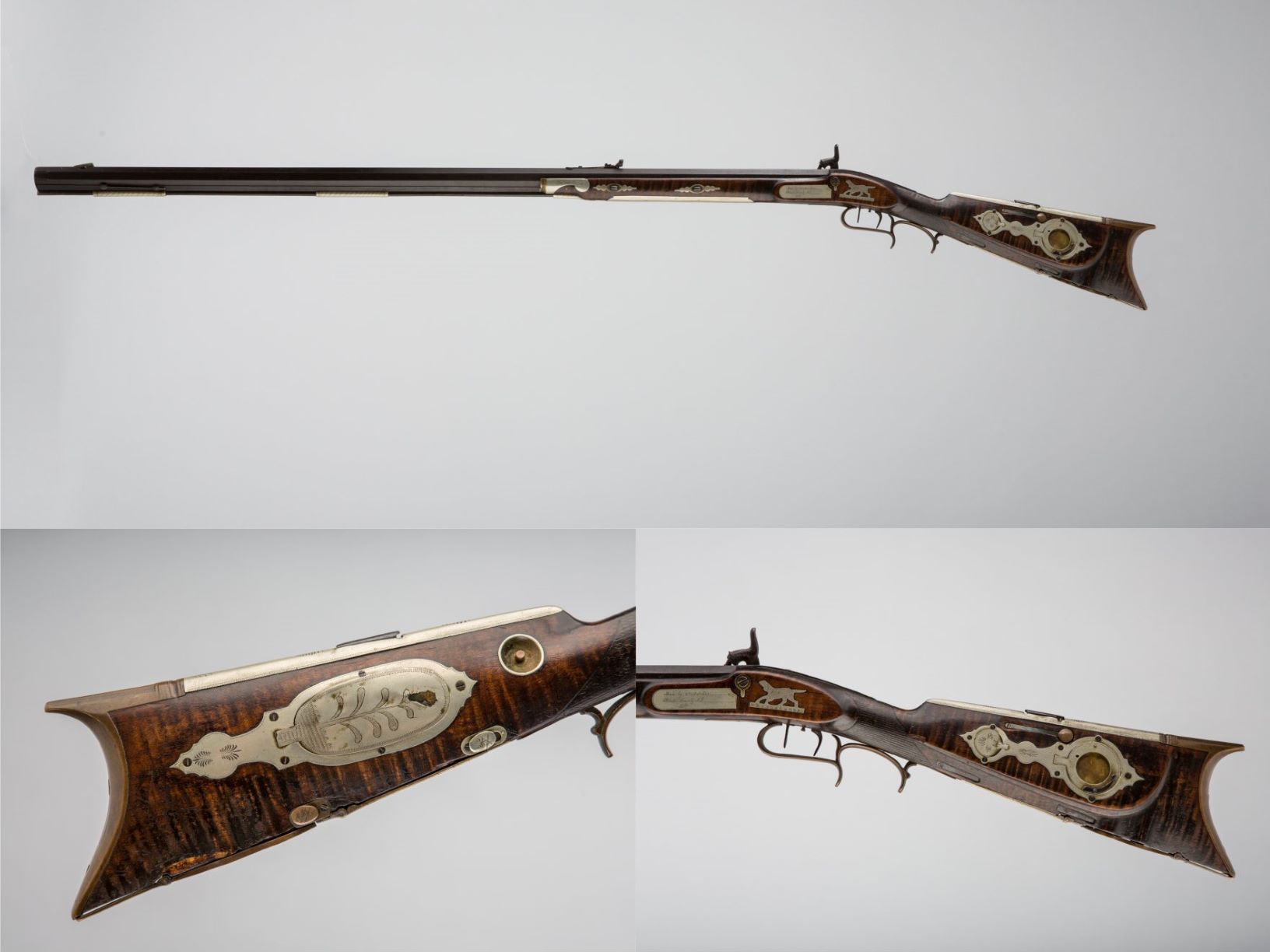By Carey Voss, Curator of Exhibits, and Victoria Chandler, Arkansas Made Researcher
"Unnecessary” adornment: beauty and utilitarian objects.
Open any contemporary home décor magazine and you will see page after page of spacious, well-lit kitchens. Every detail seems thoughtfully considered, from the countertops and custom tile backsplash to the color of the professional gas range. Given an abundance of wealth, most people would choose to surround themselves with beautiful objects and experiences. Why do humans adorn even utilitarian objects like bedding, dishware, guns, and furniture? What is the function of beauty in a utilitarian object? The short answer is that beauty makes us feel GOOD. Even Marie Kondo tells us to keep what “sparks joy” and discard the rest. Whether we’re contemplating a painting, listening to music, or cooking dinner in our perfect kitchen, experiences of beauty bring us pleasure, and all humans seek pleasure.

Half-stock Caplock Rifle, William O. Robertson, Pulaski County, 1870. Steel, iron, copper, coin silver, walnut stock. Overall length: 55 in., barrel length: 38 ¼ in., bore size: 3/8 in., Collection of Historic Arkansas Museum, Purchased with donations from David Crews, Adron and Ginger Crews, Allen McKay, Nellie Mosley, Andy Edwards, Jim and Peggy Jones, Don Winton, Rush Harding, David Alexander, Fadjo Cravens Jr., Don Hamilton, and Dr. Charles Haynie. Accession no. 88.18
The history of Arkansas gunsmithing includes many well-known and prolific craftsmen, but a young Pulaski County man named William O. Robertson eclipsed all of them when he created this ingenious half-stock rifle. In terms of adornment, it is relatively inconspicuous. Several flashes of coin silver inlay hint that this gun is not as simple as it might initially appear, but closer inspection reveals an array of unique functional and decorative details that would take a whole paragraph to list. The technical skillset required to make this rifle is expansive; W.O. Robertson understood blacksmithing (both forge and foundry), woodworking, silversmithing, engraving, and design. That a man just 23 years old demonstrated mastery of all these techniques is astounding.
By 1870, if you needed a rifle for target practice or hunting, inexpensive but serviceable factory-built weapons were readily available. Pre-fabricated elements would’ve made W.O. Robertson’s task faster and easier, but there are no marks on any parts, indicating the craftsman created every single piece of this gun, butt to barrel. Decorative flourishes include an engraved silver nameplate and an inlaid silver hunting dog on the left side of the gun, and on the right side, another compartment is engraved with a surprisingly delicate stylized tree or floral design. Engraved silver buttons activate spring-triggered mechanisms that open many hidden accessory compartments.
Unnecessary ornaments like inlaid silver, gold, and precious gems are often features of (mostly ceremonial) presentation rifles, meant to advertise the wealth and status of the owner, but details like a silver patch protecting the wooden stock beneath the hammer indicate that this gun was made for shooting. I imagine the young gunsmith in the woods with a group of close friends, beaming with pride as he revealed his beautiful new rifle. Truly, this weapon must have been a pleasure to use, and the envy of every sportsman who hunted with W.O. Robertson.
.jpg?sfvrsn=f55ead2b_1)
Chest of Drawers, Lawrence Thompson, Greene County, circa 1845. Cherry and tulip poplar, 40 7/8 x 43 3/4 x 17 3/8 in. Collection of Historic Arkansas Museum, Gift of Sue Thweatt. Accession no. 79.11
In the late 1970s, donor Sue Thweatt recounted somewhat apologetically, “we were always told that this chest was made by our great grandfather, Laurence Thompson… It is very primitive and crude, yet remarkable when you realize the tools available at that time.” While it is true that this chest of drawers is relatively simple in form, it is also a testament to the inherent beauty of wood as a material and a rare example of early Arkansas furniture.
Laurence Thompson (1799-1856) arrived in Arkansas as early as 1821 and settled in Greene County in a unique natural area now known as Crowley’s Ridge. Though thousands of acres of old-growth forests covered much of Arkansas, 19th century furniture makers favored three woods for construction – southern yellow pine, walnut, and cherry. If they wanted to incorporate a decorative element, sought-after mahogany veneers were available in river port towns near the Mississippi River and its tributaries. Fortunately, Laurence Thompson took advantage of the mixed forests near his home, where trees like oak and hickory, as well as American beech, sugar maple, and tulip poplar grew in abundance. A cabinetmaking wood favored by craftsmen east of the Mississippi, tulip or yellow poplar is indigenous in Arkansas only along Crowley’s Ridge, a narrow chain of rolling hills extending from southern Missouri to eastern Arkansas. Thompson adorned his deep cherry chest of drawers with fanciful fan-shaped tulip poplar inlay, creating visual interest in what is otherwise a practical but well-made piece of furniture. While many Arkansas chest of drawers share a similar form, the attractive but unnecessary tulip poplar embellishments make this piece unique.
Two smaller top drawers feature fine lines of inlay, while line and spandrel or quarter-fan inlays accentuate four larger drawers. The spandrel details echo neoclassical elements reminiscent of furniture likely found in his parents’ home in Kentucky. Perhaps Laurence was driven by nostalgia -- an attempt to connect with geographically distant kin by re-creating furniture from his childhood. Or maybe he wanted to add a moment of beauty to his own household, for the delight and pleasure of his family and guests. In a time before Target and Ikea, Martha Stewart and Rachel Ray, every item a person owned was significant, and even utilitarian objects had more than one function.
Connect: Do you have a favorite coffee mug, handcrafted knife, quilt, or another utilitarian object? What makes it special? How does it make you feel to use it?
.jpg?sfvrsn=f55ead2b_1&MaxWidth=510&MaxHeight=300&ScaleUp=false&Quality=High&Method=ResizeFitToAreaArguments&Signature=9BADB8F6D37A8E65EF3A171A0D4A2BEC3941FBB5)